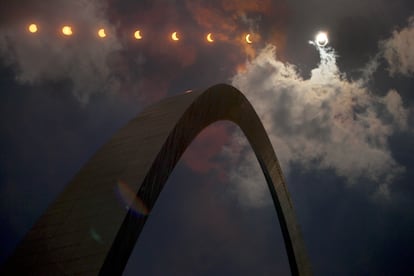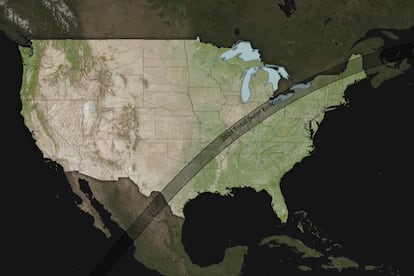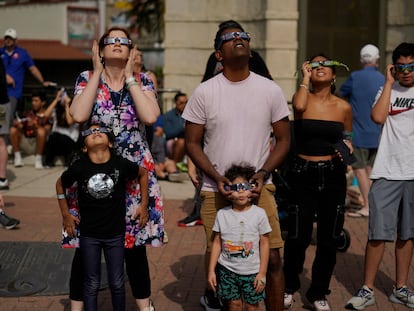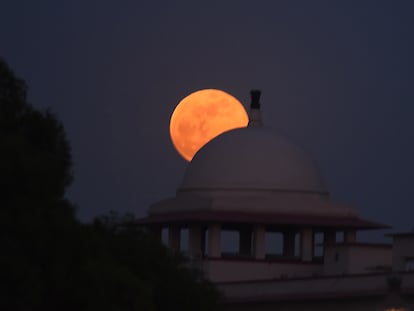Total Solar Eclipse 2024 in America: when is it and where to watch
It will be the last phenomenon of this kind visible in the contiguous United States in 20 years

On April 8, 2024, a Total Solar Eclipse will be visible across North America. A solar eclipse is a phenomenon where the Moon passes between the Earth and the Sun, obscuring the image of the Sun. A total solar eclipse occurs when the Moon blocks all direct sunlight, having a larger apparent diameter than the Sun’s, which “turns day into darkness”. Although the partial solar eclipse is visible over a wide area, totality can be seen only in small parts of the Earth’s surface.
This will be the first of its kind to be visible in the U.S. since August 21, 2017, the first in Mexico since July 11, 1991, and the first in the provinces of Canada since February 26, 1979. It will be the last total solar eclipse in the U.S. until August 23, 2044.
During the astronomical phenomenon, NASA will carry several experiments to better understand the sun. It will launch sounding rockets and WB-57 high altitude planes to collect data that can only be obtained during an eclipse after the moon blocks the sun’s light. Scientists will analyze how solar material flows from the sun as well as the energetic solar activity during the eclipse.
When is the Total Solar Eclipse of 2024?
The eclipse will occur on April 8, 2024.
How long will it last?
The Total Solar Eclipse’s duration of totality will be up to four minutes and 27 seconds. Totality is the time period where the moon completely blocks the sun. Its path of totality will be around 112 miles wide. Its longest duration of totality will be of four minutes and 28.13 seconds near the Mexican town of Nazas, Durango and the city of Torreón, Coahuila.

Is it safe to watch?
According to NASA, it is not safe to look directly at the Sun without specialized eye protection for solar viewing, except during the brief total phase of the Total Solar Eclipse, when the Moon blocks the Sun completely. The agency states: “Viewing any part of the bright Sun through a camera lens, binoculars, or a telescope without a special-purpose solar filter secured over the front of the optics will instantly cause severe eye injury”.
To watch the eclipse in its partial phases, its necessary to look through safe solar viewing glasses (commonly known as “eclipse glasses”) or a handheld solar viewer.
Where will it pass?
The Total Solar Eclipse will begin over the South Pacific Ocean and will pass over Mexico, the United States and Canada. It will first enter Mexico’s Pacific coast at around 11.07 a.m. PDT.

In the United States
The eclipse will enter the United States in Texas, and it will pass through Oklahoma, Arkansas, Missouri, Illinois, Kentucky, Indiana, Ohio, Pennsylvania, New York, Vermont, New Hampshire, and Maine. A partial solar eclipse will be visible in the rest of the contiguous United States.
When does it start?
In the U.S., totality will begin in Texas at 1.27 p.m. CDT, ending in Maine at 3.55 p.m. EDT. Here’s a table with the times for every area.
| Location | Partial Begins | Totality Begins | Maximum | Totality Ends | Partial Ends |
|---|---|---|---|---|---|
| Dallas, Texas | 12:23 p.m. CDT | 1:40 p.m. CDT | 1:42 p.m. CDT | 1:44 p.m. CDT | 3:02 p.m. CDT |
| Idabel, Oklahoma | 12:28 p.m. CDT | 1:45 p.m. CDT | 1:47 p.m. CDT | 1:49 p.m. CDT | 3:06 p.m. CDT |
| Little Rock, Arkansas | 12:33 p.m. CDT | 1:51 p.m. CDT | 1:52 p.m. CDT | 1:54 p.m. CDT | 3:11 p.m. CDT |
| Poplar Bluff, Missouri | 12:39 p.m. CDT | 1:56 p.m. CDT | 1:56 p.m. CDT | 2:00 p.m. CDT | 3:15 p.m. CDT |
| Paducah, Kentucky | 12:42 p.m. CDT | 2:00 p.m. CDT | 2:01 p.m. CDT | 2:02 p.m. CDT | 3:18 p.m. CDT |
| Carbondale, Illinois | 12:42 p.m. CDT | 1:59 p.m. CDT | 2:01 p.m. CDT | 2:03 p.m. CDT | 3:18 p.m. CDT |
| Evansville, Indiana | 12:45 p.m. CDT | 2:02 p.m. CDT | 2:04 p.m. CDT | 2:05 p.m. CDT | 3:20 p.m. CDT |
| Cleveland, Ohio | 1:59 p.m. EDT | 3:13 p.m. EDT | 3:15 p.m. EDT | 3:17 p.m. EDT | 4:29 p.m. EDT |
| Erie, Pennsylvania | 2:02 p.m. EDT | 3:16 p.m. EDT | 3:18 p.m. EDT | 3:20 p.m. EDT | 4:30 p.m. EDT |
| Buffalo, New York | 2:04 p.m. EDT | 3:18 p.m. EDT | 3:20 p.m. EDT | 3:22 p.m. EDT | 4:32 p.m. EDT |
| Burlington, Vermont | 2:14 p.m. EDT | 3:26 p.m. EDT | 3:27 p.m. EDT | 3:29 p.m. EDT | 4:37 p.m. EDT |
| Lancaster, New Hampshire | 2:16 p.m. EDT | 3:27 p.m. EDT | 3:29 p.m. EDT | 3:30 p.m. EDT | 4:38 p.m. EDT |
| Caribou, Maine | 2:22 p.m. EDT | 3:32 p.m. EDT | 3:33 p.m. EDT | 3:34 p.m. EDT | 4:40 p.m. EDT |
Sign up for our weekly newsletter to get more English-language news coverage from EL PAÍS USA Edition
Tu suscripción se está usando en otro dispositivo
¿Quieres añadir otro usuario a tu suscripción?
Si continúas leyendo en este dispositivo, no se podrá leer en el otro.
FlechaTu suscripción se está usando en otro dispositivo y solo puedes acceder a EL PAÍS desde un dispositivo a la vez.
Si quieres compartir tu cuenta, cambia tu suscripción a la modalidad Premium, así podrás añadir otro usuario. Cada uno accederá con su propia cuenta de email, lo que os permitirá personalizar vuestra experiencia en EL PAÍS.
¿Tienes una suscripción de empresa? Accede aquí para contratar más cuentas.
En el caso de no saber quién está usando tu cuenta, te recomendamos cambiar tu contraseña aquí.
Si decides continuar compartiendo tu cuenta, este mensaje se mostrará en tu dispositivo y en el de la otra persona que está usando tu cuenta de forma indefinida, afectando a tu experiencia de lectura. Puedes consultar aquí los términos y condiciones de la suscripción digital.
More information
Archived In
Últimas noticias
NASA discovers Titan doesn’t have an ocean, but a ‘slushy ice layer’ that increases possibility of life
Innocence lost in the forest of the child soldiers: ‘Each leader of the armed group had his girls’
‘Fallout’ or how the world’s largest company turned an anti-capitalist apocalyptic Western into a phenomenon
From inflation to defending migrants: Eileen Higgins and Zohran Mamdani inaugurate the new Democratic resistance against Trump
Most viewed
- ‘El Limones’ and the growing union disguise of Mexican organized crime
- Christian Louboutin: ‘Young people don’t want to be like their parents. And if their parents wear sneakers, they’re going to look for something else’
- The low-cost creative revolution: How technology is making art accessible to everyone
- ‘We are dying’: Cuba sinks into a health crisis amid medicine shortages and misdiagnosis
- A mountaineer, accused of manslaughter for the death of his partner during a climb: He silenced his phone and refused a helicopter rescue











































